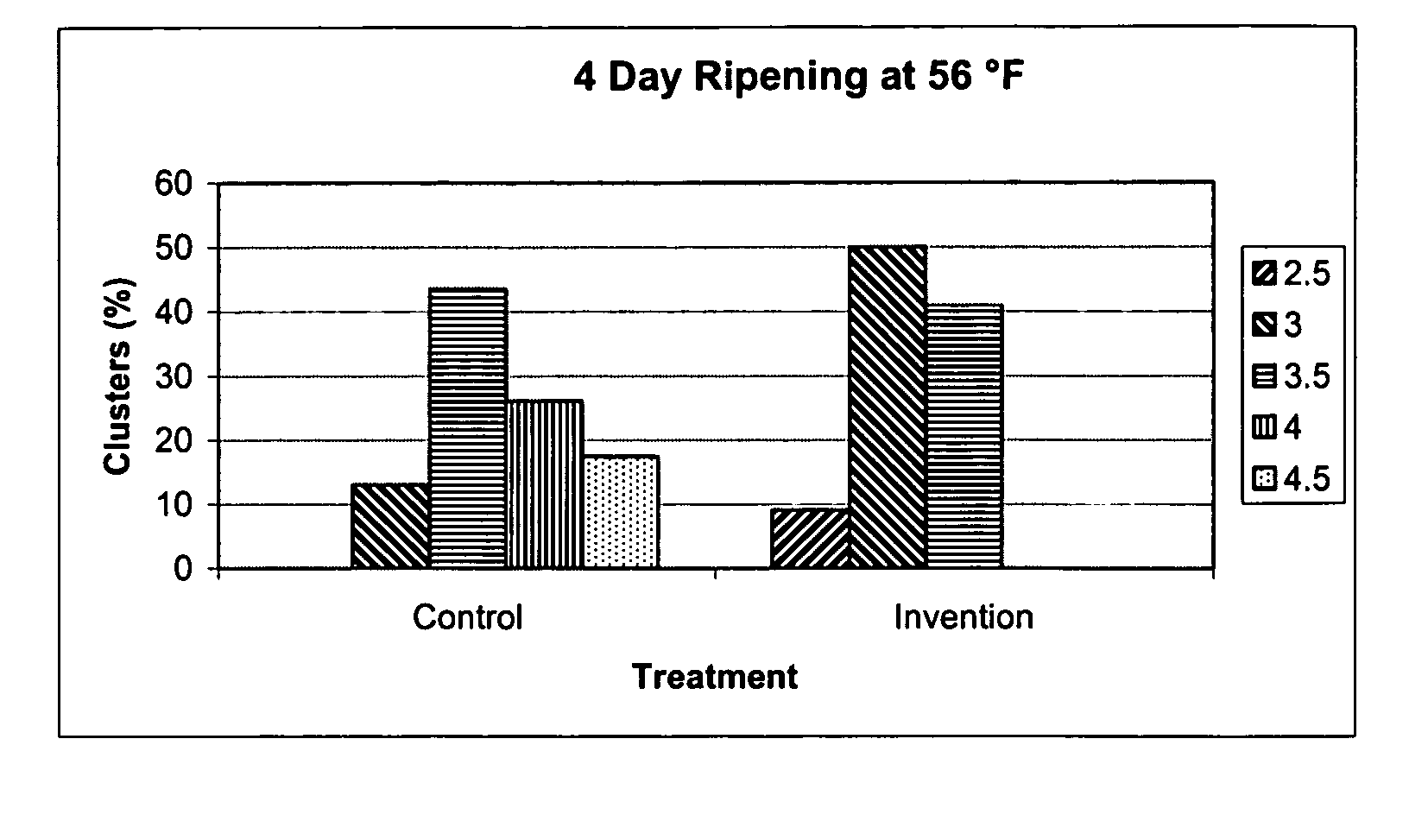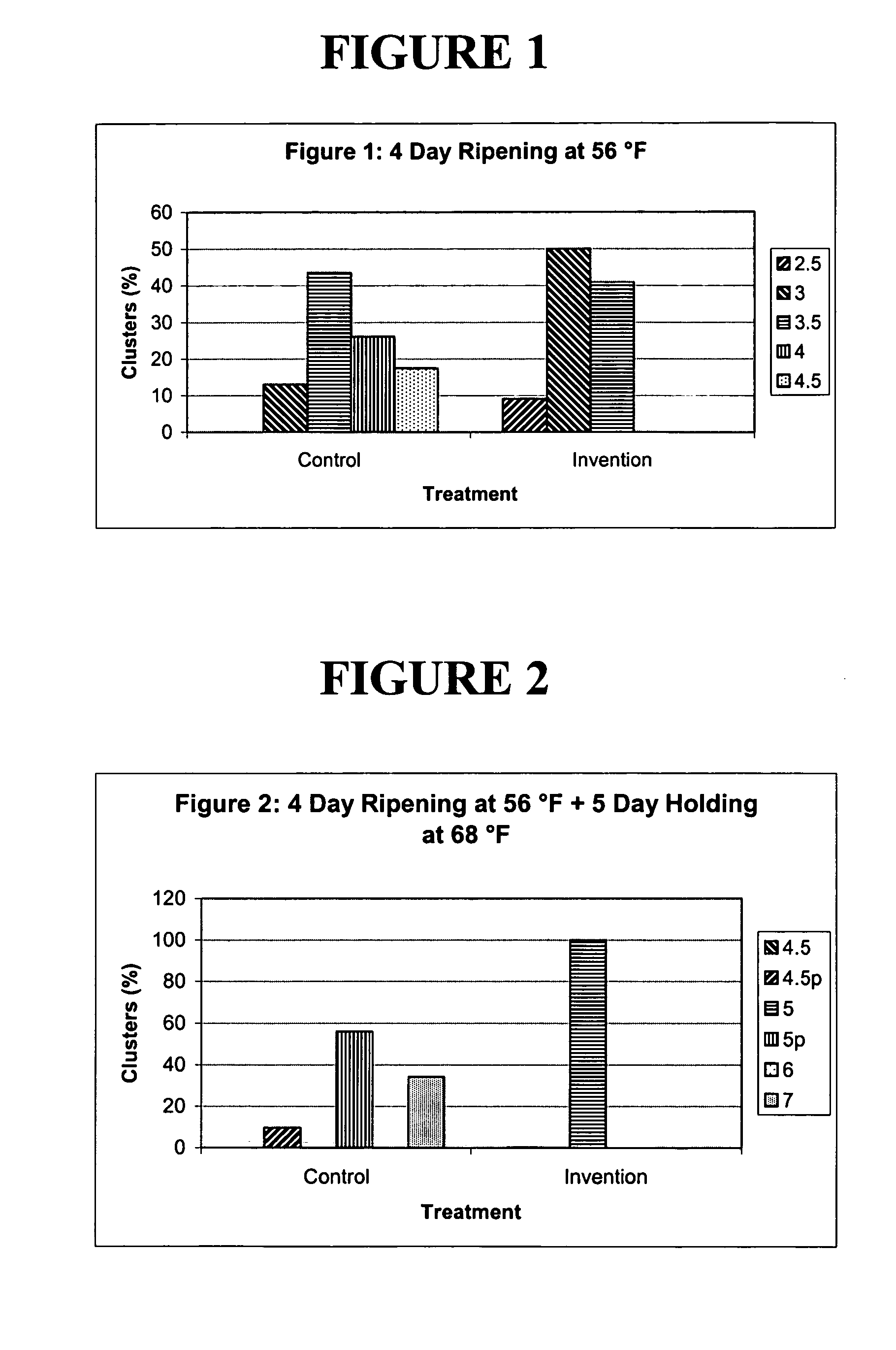Packaging material and method for perishable food product
a technology for packaging materials and food products, applied in the direction of packaging foodstuffs, packaging goods, containers preventing decay, etc., can solve the problems of reducing the quantity of fruit purchased
- Summary
- Abstract
- Description
- Claims
- Application Information
AI Technical Summary
Benefits of technology
Problems solved by technology
Method used
Image
Examples
example 1
[0035] In Example 1, the effect of various combinations of package O2 and CO2 on peel blackening and storability of the banana fruit was studied. Bags 12 inches wide and 17.7 inches long were made from microperforated monolayer styrene butadiene (XC) film. Perforations were sized at 120μ in diameter (for Treatments 1 through 3 in Table 1) and 1000μ in diameter (for Treatment 4). The number of holes per unit of film area (424.8 square inches) for 3 pounds of bananas was adjusted as follows:
[0036] 1. 10 holes of 120μ size / bag
[0037] 2. 30 holes of 120μ size / bag
[0038] 3. 42 holes of 120μ size / bag
[0039] 4. 30 holes of 1000μ size / bag
[0040] Fruit at color stage 4 was heat sealed into these bags and further progression of fruit ripening and senescence was studied for a 7 day holding period at 20° C. From this study, one will note that with O2 levels achieved in treatments 2 and 3 (4.3% and 5.7%) in combination with 14.5 to 15% CO2, an increase of 3 days in shelf life extension was achi...
example 2
[0041] In Example 2, the effect of a microperforated LDPE bag on ripening to color stage 3.5 at 56° F. in a standard ripening room and subsequent color progression at 68° F. FIGS. 1 and 2) was evaluated.
[0042] As shown in FIG. 1, a ripening scale of 1 to 7 (where 1 is complete green, 7 is full yellow with onset of sugar spots, and the remaining stages represent increase in yellowness with increase in color stage) was used for evaluating the color progression of fruits. Notably, 90% of the fruits packaged in a microperforated bag in accordance with the invention herein reached color stage 3-3.5 on day 4 of ripening. This evidences the fact the package and method of the instant invention does not lead to any commercially measurable delay to supermarket-preferred color stages.
[0043] Likewise, as shown in FIG. 2, use of the package and method according to the invention leads to highly uniform color, as evidenced by the fact that all fruit packaged according to the invention exhibited ...
example 3
[0044] In example 3, the effect of macro-perforated LDPE bag and micro-perforated LDPE bag packaging on the ripening and storability of green bananas was determined. Green banana fruits were packaged in commercially used macroperforated LDPE bags and in microperforated LDPE bags according to the invention, stored for 2 weeks at 58° F. to simulate actual transit conditions, and ripened with ethylene for an additional 4 days at 62° F. At color stage 3.5, the fruits were pulled out of storage and held at 68° F. for subsequent color progression, shelf life, and quality evaluations. Upon inspection, it was confirmed that LDPE bags according to the invention did not delay the ripening process to color stage 3.5, provided highly uniform ripening, extended the yellow life of the bananas, did not interfere with the usual taste and flavor quality of the bananas, caused the fruit to maintain higher firmness during storage post color stage 3.5, and led to 3 days of extension in shelf life of th...
PUM
| Property | Measurement | Unit |
|---|---|---|
| temperature | aaaaa | aaaaa |
| shrinkage | aaaaa | aaaaa |
| diameter | aaaaa | aaaaa |
Abstract
Description
Claims
Application Information
 Login to View More
Login to View More - R&D
- Intellectual Property
- Life Sciences
- Materials
- Tech Scout
- Unparalleled Data Quality
- Higher Quality Content
- 60% Fewer Hallucinations
Browse by: Latest US Patents, China's latest patents, Technical Efficacy Thesaurus, Application Domain, Technology Topic, Popular Technical Reports.
© 2025 PatSnap. All rights reserved.Legal|Privacy policy|Modern Slavery Act Transparency Statement|Sitemap|About US| Contact US: help@patsnap.com



